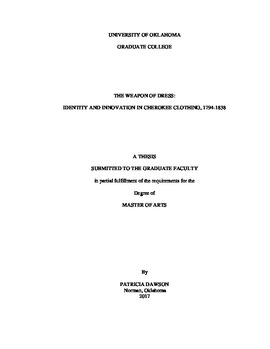| dc.contributor.advisor | Kruer, Matthew | |
| dc.contributor.author | Dawson, Patricia | |
| dc.date.accessioned | 2017-06-07T21:00:24Z | |
| dc.date.available | 2017-06-07T21:00:24Z | |
| dc.date.issued | 2017-05-12 | |
| dc.identifier.uri | https://hdl.handle.net/11244/50932 | |
| dc.description.abstract | In the decades leading up to Removal, Cherokees underwent a variety of sartorial changes. This thesis examines these changes, the resulting tensions, and the use of clothing as a weapon of resistance against Removal. Rather than acculturation or selective adoption, these sartorial changes represent indigenous cultural innovation. Cherokees reinforced their culture not through static adherence to “traditional” dress, but through innovation. These changes were indigenous and the result of an internal struggle over sartorial identity. Through narratives of sartorial transformation, Cherokees presented themselves as sufficiently acculturated and “civilized,” thus using dress as part of the identity process and as a means of presenting a different identity that emphasized “civilization” and affinity to Euro-American culture. Cherokees used sartorial innovation as acts of identity and as a weapon of resistance against Euro-American encroachment. | en_US |
| dc.language | en_US | en_US |
| dc.subject | History, United States. | en_US |
| dc.subject | Clothing | en_US |
| dc.subject | History of Dress | en_US |
| dc.subject | Cherokee | en_US |
| dc.subject | Native American History | en_US |
| dc.subject | Indian Removal | en_US |
| dc.title | The Weapon of Dress: Identity and Innovation in Cherokee Clothing, 1794-1838 | en_US |
| dc.contributor.committeeMember | Watson, Mary Jo | |
| dc.contributor.committeeMember | Kelly, Catherine E. | |
| dc.date.manuscript | 2017 | |
| dc.thesis.degree | Master of Arts | en_US |
| ou.group | College of Arts and Sciences::Department of History | en_US |
| shareok.orcid | 0000-0003-0480-8923 | en_US |
| shareok.nativefileaccess | restricted | en_US |
